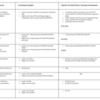Thank you to everyone who joined our webinars, Technical Office Hours, or Impact Collaborative session. We enjoy engaging with you about the SEED Method and look forward to answering more questions! For your convenience, we have compiled answers to frequently asked questions about the SEED Method below.
We are available for one on one technical assistance. Schedule an appointment using this form HERE.
Frequently Asked Questions about the SEED Method
- Who developed the SEED Method?
- The SEED Method was funded through a Patient- Centered Outcomes Research Institute (PCORI) Award (#1310-07664) to Emily Zimmerman (Principal Investigator), Center on Society and Health at Virginia Commonwealth University. The toolkit was developed by members of the SEED method team - Emily Zimmerman and Sarah Cook.
- You can learn more about the SEED Method in Webinar 1 HERE and download the SEED Method toolkit.
- Does the SEED Method follow principles of community-based participatory research(CBPR)?
- Yes, the SEED Method uses a CBPR approach. It is led by a participatory research team and uses principles of CBPR throughout the process.
- You can learn more about it in Webinar 1 HERE.
- Who can use the SEED Method?
- Projects requiring engagement of stakeholders at multiple levels of participation.
- Those planning stakeholder-engaged research, or example, engaging stakeholders in creating a research agenda and prioritizing research topics.
- Projects creating responsive strategies and action plans to community identified needs.
- Researchers involved in community-engaged research.
- Service Organizations – including community-based health systems - seeking richer community engagement to direct their services.
- Community coalitions working to solve significant issues impacting their community.
- You can learn more about the Research Team in Webinar 2, HERE.
- Where can I get the toolkit? Is the toolkit free?
- Yes, all SEED materials are FREE and are available for download in the Resources section of the subgroup.
- How do I use the toolkit?
- Many of the toolkit materials are presented as templates to be customized by users, including areas that require project-specific details, such as the [research topic] and [Research Team name]. These are presented in red font.
- Throughout the toolkit, you will find examples from the two SEED Method demonstration projects, including meeting agendas, presentation slides, timelines, and organizational documents. They are provided to orient users and illustrate final versions of project materials.
- Evaluation materials are provided for those who want to evaluate SEED Method processes or outcomes.
- All SEED materials are available for download in the Resources section of the subgroup.
- What customizable tools does the SEED Method Toolkit include?
- Stakeholder Identification and Recruitment Matrices
- Facilitator guides
- Meeting agendas and schedules
- Guidance on engaging in participatory research -- You can learn more about it in Webinar 1 HERE and Webinar 2, HERE.
- Creating conceptual models/ diagramming causal pathways - You can learn more about it in Training video 2 HERE and Training video 3 HERE.
- Who participates in the SEED Method?
- The SEED Method is unique because it offers three levels of stakeholder engagement, they are:
- 1. The Research Team - collaborative engagement. This community-based participatory research (CBPR) team collaboratively leads the research. You can learn more about it in Webinar 2, HERE.
- 2. Topic Groups - participatory engagement. These groups of stakeholders are brought together based on their experience and knowledge of the health-related topic. You can learn more about it in Webinar 3, HERE.
- 3. SCAN participants - consultative engagement participate in focus groups and interviews. You can learn more about it in Webinar 3, HERE.
- How do you select SCAN participants?
- SCAN participants provide additional stakeholder voices and expertise to the project diversifying perspectives.
- SCAN participants can be selected by the Topic Groups or by the Research Team to fill in gaps and include diverse community perspectives on the project issue.
- When selecting SCAN participants, team members should think about the type of community expertise that is missing on the team and whose perspectives they would like to bring in.
- You can learn more about it in Webinar 3, HERE.
- Is a topic group similar to a focus group?
- No. The Topic groups meet on multiple occasions, create conceptual models of the project topic, develop research question or responses, and make decisions about the ultimate product. Focus groups meet on one occasion to provide their perspectives on the project topic.
- You can learn more about topic groups in Webinar 3, HERE.
- How has the SEED Method already been used?
- To date, the SEED Method has been used on stakeholder driven health research related to:
- How long does the SEED Method take?
- The SEED Method was designed to take place in six steps over nine months, however, the method is flexible and scalable to fit with alternative timelines and objectives.
- In the toolkit, there are four recommended scenarios for scaling down the current SEED Method process and timeline, ranging from longest to shortest implementation time, these include: 1 meeting, 6 weeks, 4 months, or 9-12 months.
- How much does the SEED Method cost?
- The SEED method can be adapted for projects of varying scope in a variety of ways, this includes adapting it to fit your project timeline and project budget.

- Table from: Zimmerman, E. B., Rafie, C. L., Moser, D. E., Hargrove, A., Noe, T., & Adams Mills, C. (2020). Participatory Action Planning to Address the Opioid Crisis in a Rural Virginia Community Using the SEED Method. Journal of Participatory Research Methods, 1(1). https://doi.org/10.35844/001c.13182
- The SEED method can be adapted for projects of varying scope in a variety of ways, this includes adapting it to fit your project timeline and project budget.
- What are the next steps if we would use the SEED Method? Is there a SEED Method training offered?
- There are 4 training videos available on the Connect Extension subgroup page.
- We also offer 1:1 Technical Assistance. To request support, reach out to us HERE.
- If you plan to use the SEED Method, please let us know, by posting on the Subgroup Discussion Board and we will reach out with information on how you can join our SEED Method Learning Collaborative.


Comments (0)